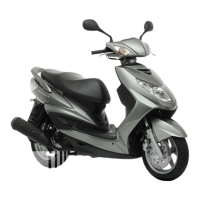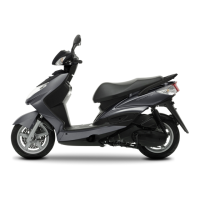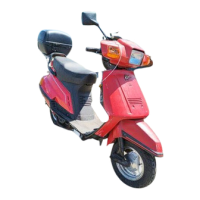
Do you have a question about the Yamaha CYGNUS.X XC125 and is the answer not in the manual?
| Displacement | 125 cc |
|---|---|
| Cooling System | Air-cooled |
| Fuel System | Fuel Injection |
| Transmission | V-belt automatic |
| Front Suspension | Telescopic fork |
| Rear Suspension | Unit swing |
| Rear Brake | Drum brake |
| Front Tire | 110/70-12 |
| Bore x Stroke | 52.4 mm x 57.9 mm |
| Compression Ratio | 10.0:1 |
| Starter | Electric |
| Fuel Tank Capacity | 6.5 liters |
| Engine Type | 4-stroke, SOHC |
| Front Brake | Disc |
| Weight | 119 kg |
Owner's responsibility for safe vehicle operation.
Emphasizes pre-operation checks for safe condition.
Details essential protective gear for rider safety.
Precautions and dangers of carbon monoxide exposure.
Guidelines for cargo, weight limits, and vehicle stability.
Safety considerations for aftermarket parts and modifications.
Instructions for safely transporting the scooter in another vehicle.
Additional advice for safe riding and hazard awareness.
Identifies key components on the left side of the scooter.
Identifies key components on the right side of the scooter.
Locates and names main controls and instrument panel.
Operation and positions of the main switch/steering lock.
Steps to unlock the steering mechanism.
Meaning of dashboard indicator and warning lights.
Explanation of speedometer and multi-function display functions.
Modes and settings for odometer, tripmeter, and clock.
Function of left and right handlebar switches.
Location and operation of front and rear brake levers.
Opening/closing fuel cap and refueling precautions.
Information on catalytic converters and using the kickstarter.
Accessing seat and using storage compartments.
Location and operation of the sidestand.
Explanation and check of the ignition circuit cut-off system.
Pre-operation check for fuel level and leaks.
Pre-operation check for engine oil level and leaks.
Pre-operation checks for front/rear brakes and fluid.
Pre-operation checks for tire condition, tread, and pressure.
Checks for chassis fasteners, lights, switches, and sidestand.
Step-by-step guide to starting the engine.
Procedures for starting off and controlling speed.
Safe braking methods and precautions.
Advice on improving fuel efficiency.
Guidelines for the engine break-in period (0-1000 km).
Safe practices for parking the scooter.
Importance of periodic inspection, adjustment, and lubrication.
Location and purpose of the owner's tool kit.
Maintenance schedule for emission control components.
Comprehensive chart for general maintenance and lubrication tasks.
Care for air filters and hydraulic brake service.
Steps for removing and installing body panels.
How to check and inspect the spark plug.
Procedure for checking and changing engine oil and strainer.
Procedure for checking and changing final transmission oil.
Steps for replacing the air filter element.
Checking throttle grip play and valve clearance.
Tire pressure, inspection, and wheel care.
Checking/adjusting brake levers, pads, shoes, and fluid.
Lubricating cables, throttle grip, and brake levers.
Checking front fork, steering, and wheel bearings.
Battery care, charging, and fuse replacement.
Procedures for replacing headlight, signal, and auxiliary bulbs.
General troubleshooting and a detailed chart for common issues.
Precautions for cleaning matte colored parts.
Instructions and warnings for cleaning the scooter.
Instructions for short-term and long-term storage.
Key physical dimensions and weight of the scooter.
Engine type, displacement, transmission, and clutch specifications.
Engine oil, transmission oil, and fuel tank capacities.
Specifications for tires, wheels, and brake systems.
Battery, lighting, and fuse specifications.
Recording vehicle identification and model label information.











